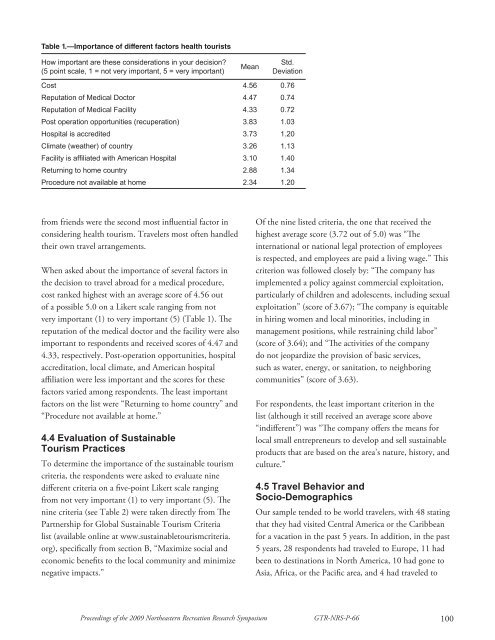Proceedings of the 2009 northeastern recreation research symposium
Proceedings of the 2009 northeastern recreation research symposium
Proceedings of the 2009 northeastern recreation research symposium
Create successful ePaper yourself
Turn your PDF publications into a flip-book with our unique Google optimized e-Paper software.
Table 1.—Importance <strong>of</strong> different factors health tourists<br />
How important are <strong>the</strong>se considerations in your decision?<br />
(5 point scale, 1 = not very important, 5 = very important)<br />
from friends were <strong>the</strong> second most infl uential factor in<br />
considering health tourism. Travelers most <strong>of</strong>ten handled<br />
<strong>the</strong>ir own travel arrangements.<br />
When asked about <strong>the</strong> importance <strong>of</strong> several factors in<br />
<strong>the</strong> decision to travel abroad for a medical procedure,<br />
cost ranked highest with an average score <strong>of</strong> 4.56 out<br />
<strong>of</strong> a possible 5.0 on a Likert scale ranging from not<br />
very important (1) to very important (5) (Table 1). Th e<br />
reputation <strong>of</strong> <strong>the</strong> medical doctor and <strong>the</strong> facility were also<br />
important to respondents and received scores <strong>of</strong> 4.47 and<br />
4.33, respectively. Post-operation opportunities, hospital<br />
accreditation, local climate, and American hospital<br />
affi liation were less important and <strong>the</strong> scores for <strong>the</strong>se<br />
factors varied among respondents. Th e least important<br />
factors on <strong>the</strong> list were “Returning to home country” and<br />
“Procedure not available at home.”<br />
4.4 Evaluation <strong>of</strong> Sustainable<br />
Tourism Practices<br />
To determine <strong>the</strong> importance <strong>of</strong> <strong>the</strong> sustainable tourism<br />
criteria, <strong>the</strong> respondents were asked to evaluate nine<br />
diff erent criteria on a fi ve-point Likert scale ranging<br />
from not very important (1) to very important (5). Th e<br />
nine criteria (see Table 2) were taken directly from Th e<br />
Partnership for Global Sustainable Tourism Criteria<br />
list (available online at www.sustainabletourismcriteria.<br />
org), specifi cally from section B, “Maximize social and<br />
economic benefi ts to <strong>the</strong> local community and minimize<br />
negative impacts.”<br />
Mean<br />
Std.<br />
Deviation<br />
Cost 4.56 0.76<br />
Reputation <strong>of</strong> Medical Doctor 4.47 0.74<br />
Reputation <strong>of</strong> Medical Facility 4.33 0.72<br />
Post operation opportunities (recuperation) 3.83 1.03<br />
Hospital is accredited 3.73 1.20<br />
Climate (wea<strong>the</strong>r) <strong>of</strong> country 3.26 1.13<br />
Facility is affi liated with American Hospital 3.10 1.40<br />
Returning to home country 2.88 1.34<br />
Procedure not available at home 2.34 1.20<br />
Of <strong>the</strong> nine listed criteria, <strong>the</strong> one that received <strong>the</strong><br />
highest average score (3.72 out <strong>of</strong> 5.0) was “Th e<br />
international or national legal protection <strong>of</strong> employees<br />
is respected, and employees are paid a living wage.” Th is<br />
criterion was followed closely by: “Th e company has<br />
implemented a policy against commercial exploitation,<br />
particularly <strong>of</strong> children and adolescents, including sexual<br />
exploitation” (score <strong>of</strong> 3.67); “Th e company is equitable<br />
in hiring women and local minorities, including in<br />
management positions, while restraining child labor”<br />
(score <strong>of</strong> 3.64); and “Th e activities <strong>of</strong> <strong>the</strong> company<br />
do not jeopardize <strong>the</strong> provision <strong>of</strong> basic services,<br />
such as water, energy, or sanitation, to neighboring<br />
communities” (score <strong>of</strong> 3.63).<br />
For respondents, <strong>the</strong> least important criterion in <strong>the</strong><br />
list (although it still received an average score above<br />
“indiff erent”) was “Th e company <strong>of</strong>f ers <strong>the</strong> means for<br />
local small entrepreneurs to develop and sell sustainable<br />
products that are based on <strong>the</strong> area’s nature, history, and<br />
culture.”<br />
4.5 Travel Behavior and<br />
Socio-Demographics<br />
Our sample tended to be world travelers, with 48 stating<br />
that <strong>the</strong>y had visited Central America or <strong>the</strong> Caribbean<br />
for a vacation in <strong>the</strong> past 5 years. In addition, in <strong>the</strong> past<br />
5 years, 28 respondents had traveled to Europe, 11 had<br />
been to destinations in North America, 10 had gone to<br />
Asia, Africa, or <strong>the</strong> Pacifi c area, and 4 had traveled to<br />
<strong>Proceedings</strong> <strong>of</strong> <strong>the</strong> <strong>2009</strong> Nor<strong>the</strong>astern Recreation Research Symposium GTR-NRS-P-66<br />
100
















